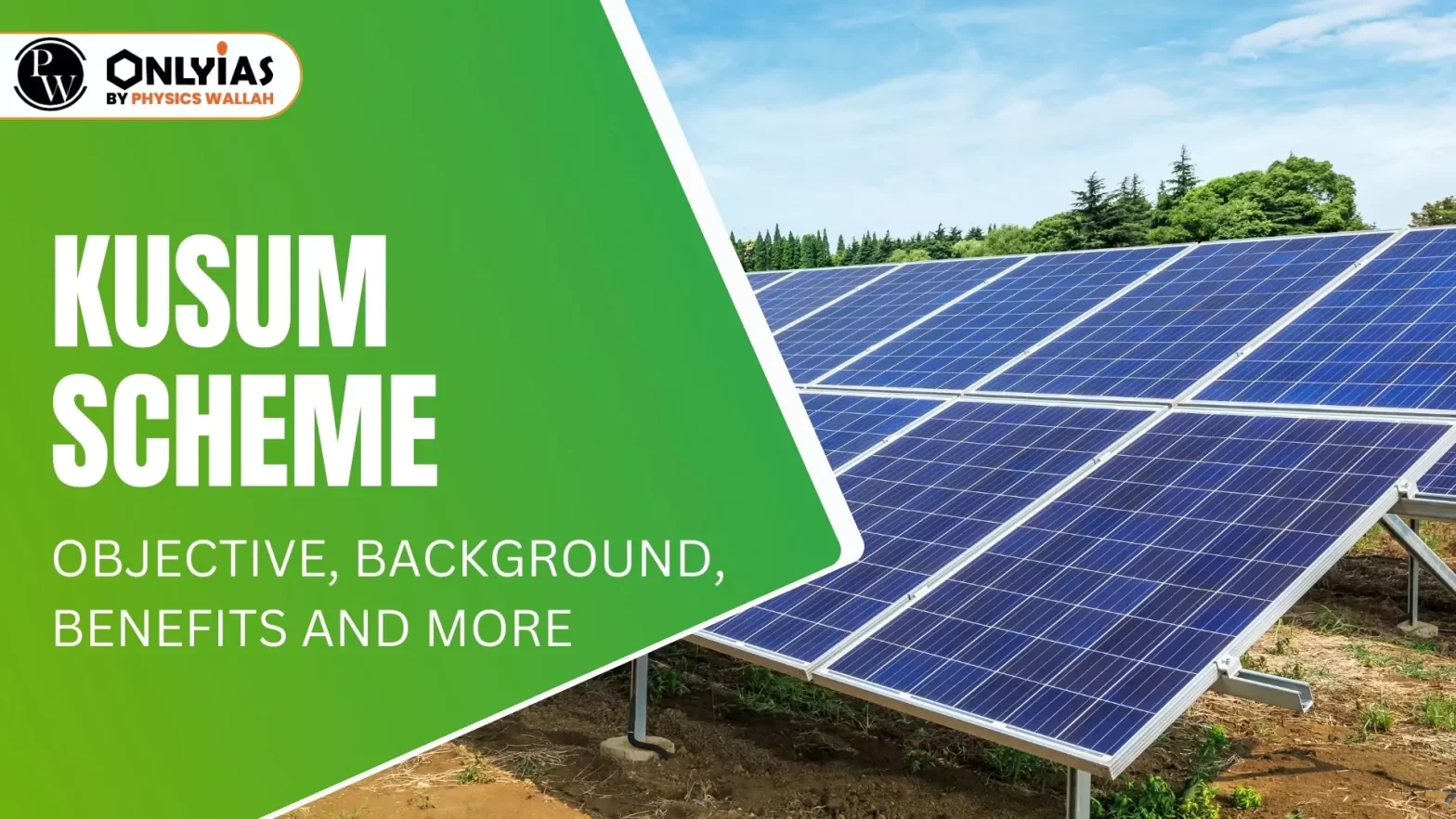The KUSUM Scheme is significant for the UPSC exam, as government schemes are integral to the general awareness and governance sections (Mains GS-II) of the UPSC Syllabus. To Know more about KUSUM scheme check out this article.

KUSUM Scheme: The Kisan Urja Suraksha evam Utthaan Mahabhiyan (KUSUM) scheme, introduced by the Central Government, is aimed at boosting solar power production in India while providing benefits of solar farming to farmers. The Union Budget 2018-19 allocated Rs. 48,000 crores for a ten-year period to support this initiative.
In March 2021, the Central Government made amendments to the PM-KUSUM scheme, focusing on solarising agricultural feeders instead of individual pumps. This modification aims to eliminate the need for replacing every existing pump in a village with a solar pump.
The KUSUM Scheme is significant for the UPSC exam, as government schemes are integral to the general awareness and governance sections (Mains GS-II) of the UPSC Syllabus.
Implemented by: The Ministry responsible for the scheme is the Ministry of New and Renewable Energy.
Components:
As part of India’s commitments under the Intended Nationally Determined Contributions (INDCs), the country aims to increase the share of non-fossil-fuel power capacity to 40% by 2030. The Cabinet approved scaling-up the solar power target from 20,000 MW to 1,00,000 MW by 2022.
Overview: PM-KUSUM is a flagship initiative launched by the Indian government in 2019, aiming to revolutionize the agricultural sector by promoting the widespread adoption of solar energy solutions. Operating on a demand-driven model, it allocates capacities based on requests from various states and union territories.
The scheme envisions a substantial addition of 30.8 GW to solar power capacity by March 31, 2026, facilitated through various components and financial support.
Water Table Depletion:
Exclusion of Small and Marginal Farmers:
The KUSUM scheme represents a transformative initiative in India’s renewable energy landscape, aiming to empower farmers and promote sustainable energy practices.
| Also Read | |
| One Nation One Ration Card Scheme (ONORCS) | NIRVIK Scheme (Niryat Rin Vikas Yojana) |
| SATAT Scheme | PM AASHA Scheme (Pradhan Mantri Annadata Aay SanraksHan Abhiyan) |
| Must Read | |
| NCERT Notes For UPSC | UPSC Daily Current Affairs |
| UPSC Blogs | UPSC Daily Editorials |
| Daily Current Affairs Quiz | Daily Main Answer Writing |
| UPSC Mains Previous Year Papers | UPSC Test Series 2024 |
The three components of the PM KUSUM Scheme are: Component-A: Establishment of 10,000 MW Decentralized Ground/Stilt Mounted Solar Power Plants on unused agricultural lands. Component-B: Installation of 20 Lakh Stand-alone Solar Pumps in off-grid areas. Component-C: Solarisation of 15 Lakh Grid-Connected Agriculture Pumps through Individual Pump Solarisation and Feeder Level Solarisation.
The Kisan Urja Suraksha evam Utthaan Mahabhiyan (KUSUM) scheme aims to augment farmers' income by offering them the opportunity to sell surplus power to the grid, utilizing solar power projects established on their unused lands.
The PM-KUSUM initiative has been prolonged until March 31, 2026, to encourage broader acceptance of solar energy solutions among farmers. State-Level Tendering: The procurement of standalone solar pumps is now open to state-level tendering, enhancing the efficiency and streamlining of the process.
Individual farmers, groups of farmers, cooperatives, panchayats, Farmer Producer Organisations (FPOs), and Water User Associations (WUAs) are eligible entities for the project. The proposed project site should be located within a 5 km radius from the nearest electricity sub-station.
To establish a solar power project with a minimum capacity of 0.5 MW, approximately 2-2.5 acres of land is required. Utilization of your land is feasible, contingent upon the willingness of individuals owning adjacent plots to allocate the remaining land, either individually or collectively.

<div class="new-fform">
</div>